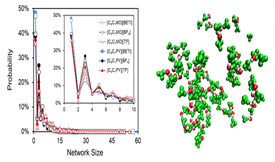
Water Solubility Trends in Ionic Liquids: The Quantitative Structure−Property Relationship Model versus Molecular Dynamics
C.E.S. Bernardes, K. Klimenko, J.N. Canongia Lopes
J. Phys. Chem. B 2021, 125, 11491−11497.
Abstract
The knowledge of water solubility in ionic liquids (ILs) is an important property with an impact on the design ofmany physical and chemical processes, like the purification of organic compounds or the establishment of decontamination procedures. The development of methods to predict or establish solubility trends in ILs is, therefore, extremely relevant, as it may avoid expensive and time-consuming experimental procedures. In this work, we compare results of water solubility in ILs predicted by a quantitative structure−property relationship (QSPR) model with trends found using aggregation studies in molecular dynamics (MD) simulation results. This study was performed for ILs combining the cations 1-butyl-1-methylpyrrolidinium and 1-butyl-1-methylmorpholinium, with the anions bis-(pentafluoroethylsulfonyl)imide (BETI-), trifluoromethanesulfonate (TF-), and tetrafluoroborate (BF4-). Both methods indicated that, at 298.15 K, the water solubility in ILs was almost independent of the investigated cations. However, if the IL is composed of a hydrophobic anion, a slight increase in the mixability of the IL with water may be observed if the cation can form H-bonds. The QSPR model indicated that the hydrophobic BETI- anion leads to solubilities (xH2O ∼ 0.33), approximately half of those predicted when the cations are combined with TF- and BF4- anions (xH2O ∼ 0.60). The MD results suggested that this difference is essentially related to the ability of the water molecules to interact with the anion. This interaction involves the formation of networks of molecules, where H2O is completely solvated by anions. These structures make the formation of interactions between water molecules difficult, which are responsible for their segregation from solution and, therefore, to liquid−liquid phase separation. For the investigated ILs, the MD data also suggest that the solubility trends are inversely proportional to the number of “isolated” anions relative to ···AN−H2O−AN−H2O··· networks
Return Previous Next